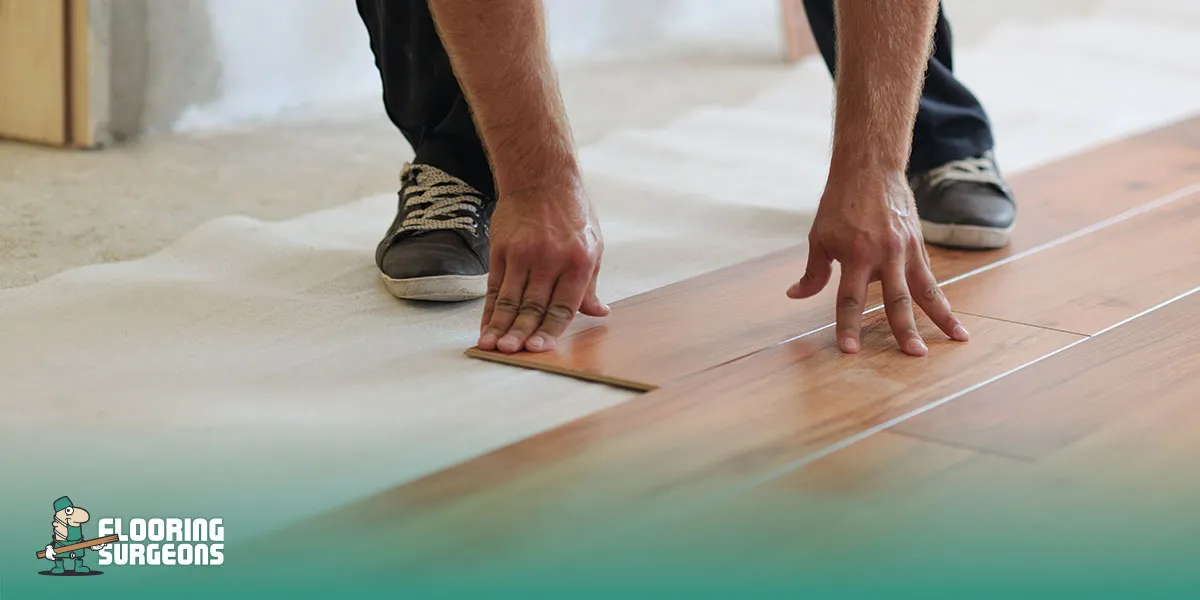Wood is one of the most popular flooring choices across the UK, offering timeless charm and elegance, but it’s also highly vulnerable to moisture. Suppose moisture and water are not correctly removed from your hardwood flooring. In that case, it will lead to warping, unsightly and stubborn stains, and mold growth, resulting in costly repairs. At Flooring Surgeons, we understand the stress of water stains, especially when you don’t know how to remove water stains from wood. But don’t worry; we’re here to guide you through how to remove water stains from wood floors. This guide is for you if you want to keep your hardwood floors in top condition for years to come.
Understanding Water Stains on Wood Floors
Identifying the type of water stain that has formed on your flooring is the first step to knowing how to remove water stains from wood floors properly.
Light water stains
Light water stains are usually easy to remove, as they only affect the surface level of the wood. These stains typically appear as light or cloudy marks on the floor. A typical example is a glass placed directly on a wooden table, leaving a water ring. Light stains are often caused by condensation from an air conditioning unit.
Dark Water Stains
Unlike light stains, dark water stains indicate a more serious moisture issue. On solid hardwood, this can mean that water has soaked into the wood grain itself, causing long-lasting stains. To remove dark water stains from wood floors, you may need to use specialized cleaning techniques, and in many cases, sanding and refinishing may be required.
Other Signs of Water Damage
• A musty smell
• Hardwood floor buckling
• Lifting nails and floorboards
• Mould growth
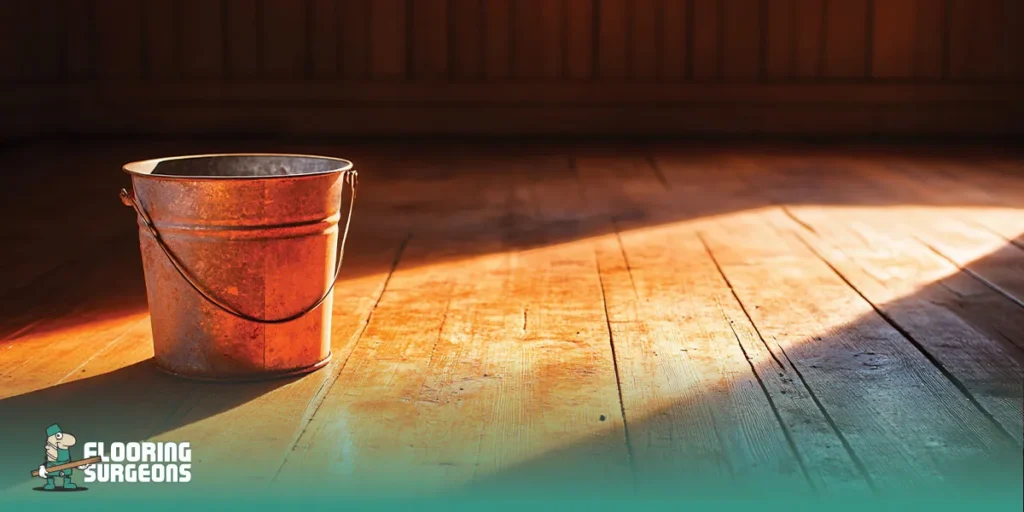
Materials You’ll Need to Remove Water Stains from Wood Floors
You will need the following materials to remove water stains from wood floors safely:
- Hairdryer
- Baking soda or table salt
- Vinegar and olive oil
- Sandpaper (for deep stains)
- Soft towel or rag
- shop-bought wood stain remover (for stubborn stains)
Additional Tips:
- Test first: Before using any cleaning solution, especially vinegar or commercial stain removers, test on a small, inconspicuous area of the floor to ensure no damage occurs.
- Use minimal moisture: Always use a damp, not wet, cloth to avoid soaking the wood, which could cause further water damage.
- Dry immediately: After applying any treatment, make sure to dry the area immediately with a soft towel to prevent additional moisture from seeping in.
Common Mistakes That Make Water Stains Worse
Many homeowners unintentionally make their water stains on wood floor problems worse by using the wrong cleaning techniques or products. One of the most common mistakes is using too much water or steam when trying to learn how to remove water stains from wood, which forces moisture deeper into the wood, turning light marks into dark water stains on wood floors.
Another mistake is applying undiluted vinegar or harsh chemical cleaners. While vinegar can help, using it improperly can strip the finish and cause long-term wood floor water damage. The same applies to abrasive tools or sanding before assessing the severity of the stain; this can ruin your floor’s surface permanently.
At Flooring Surgeons, experts in professional wood and laminate flooring, we often see damage caused by DIY fixes gone wrong. That’s why we recommend following safe, step-by-step methods using gentle products like a wooden floor stain remover or mild baking soda paste before attempting anything more aggressive. Proper cleaning not only preserves your floor’s beauty but also prevents costly repairs down the line.
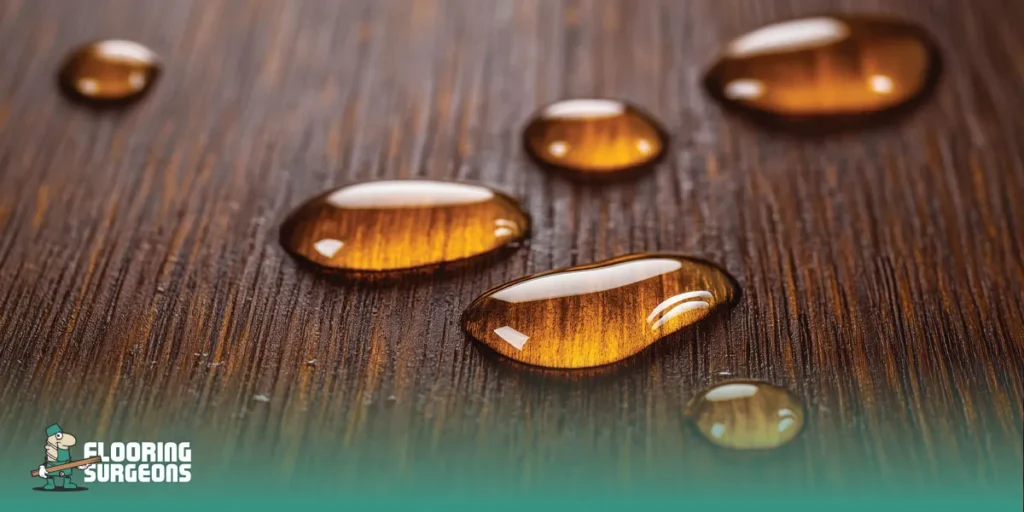
Step-by-Step Methods to Remove Water Stains from Wood Floors
There are several DIY methods to remove water stains from wood floors, but first, you need to follow these steps:
- To prevent your flooring from getting wet, you need to find and eliminate the source of the moisture. Check for leaking pipes, roof damage, or other possible causes of moisture reaching your flooring. Your cleansing efforts will be fruitless if water continues to penetrate your flooring.
- Remove excess water from the flooring with a towel or broom until the amount of moisture remaining on the floor is minimized.
- Depending on the water source, mud and mould may also be present. Clean the floor thoroughly to remove these impurities.
- Dry the area thoroughly. Setting up fans and opening windows can also help improve ventilation.
- Once you’ve completed these steps, you can try the methods below, but always test them on a hidden area first.
Using a Hair Dryer
Using a hair dryer can effectively remove white water stains caused by moisture. Set the hairdryer to its lowest setting and move it back and forth over the stain until it fades.
Salt or Baking Soda paste
Mix a teaspoon of baking soda or table salt with a few drops of water. It should be thick enough to coat the stain and wet enough to penetrate the wood flooring underneath. Apply the paste to the stain using a cloth and gently rub in circular motions. Leave it for 24 hours before wiping it clean. This method can also be effective for removing wine stains.
Vinegar and Olive Oil
A mixture of equal amounts of vinegar and olive oil can help the stain disappear. The vinegar helps lift the stain, while the olive oil is a natural furniture polish.
Apply the mixture to the water stain using a clean cloth. Finish by wiping the area with a dry towel to remove any excess residue.
If you have laminate flooring, read this: How to Clean Laminate Flooring
Treatment Based on Floor Type (Engineered, Unfinished, Laminate)
When dealing with water stains on wood floors, the treatment method largely depends on the type of flooring you have. Different materials require distinct approaches to prevent further damage and ensure a long-lasting finish. If you’re unsure how to remove water stains from wood, it’s important to identify the type of wood floor before proceeding with any treatment. Each floor type, whether engineered, unfinished, or laminate, requires specific care and cleaning methods to maintain its integrity.
Engineered Wood Floors
Engineered wood floors are designed to be more durable than solid hardwood, but can still suffer from water stains on hardwood floors if exposed to moisture for too long. To remove black water stains from engineered wood floors, gently clean the affected area with a soft cloth soaked in a mild cleaning solution, like vinegar and olive oil. For stubborn stains, use a wooden floor stain remover specifically formulated for engineered surfaces. Avoid excessive water, as this can cause the veneer layer to peel or warp.
Unfinished Wood Floors
Unfinished wood floors are more porous and susceptible to dark water stains on wood floors. If water seeps in, it can cause deep staining or swelling. For these types of floors, sanding is often required to remove stains, followed by applying a protective finish. Use baking soda paste or a gentle wood floor stain remover to lift lighter stains before deciding if sanding is necessary. Always dry thoroughly to prevent future water damage.
Laminate Floors
Laminate wood floors are generally more resistant to water than natural wood, but can still suffer from surface-level stains. To remove water stains from laminate wood floors, apply a homemade laminate floor cleaner, such as a vinegar and water mixture, or use a soft cloth with a small amount of wood floor stain remover. Since laminate flooring is synthetic, avoid soaking it with water, as excess moisture can cause the laminate to bubble or peel over time.
For maintaining these floors in the long term, consider using the WOCA Clean & Care Maintenance Kit, which offers a complete solution for cleaning and protecting your wood surfaces, ensuring they stay pristine and damage-free.
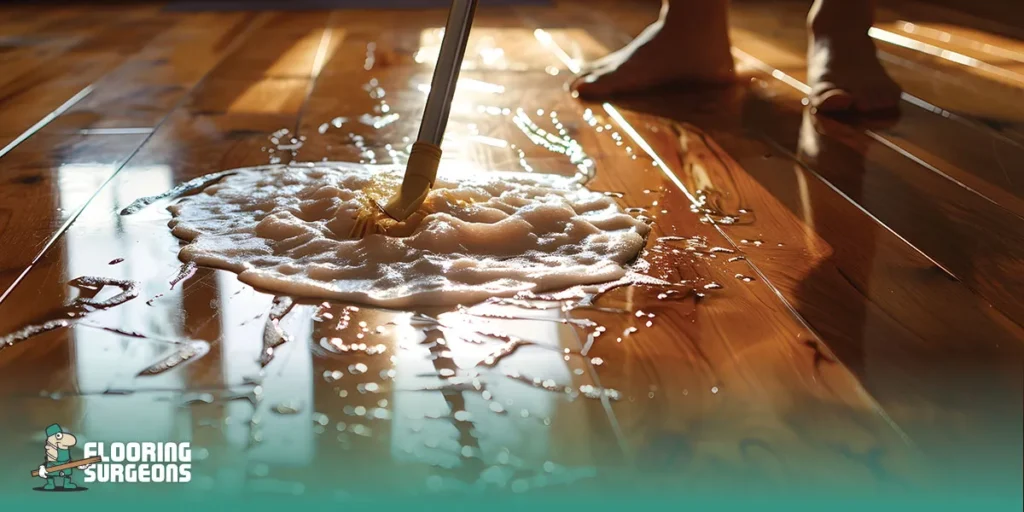
Sanding for Deep Water Stains
You can use commercial, shop-bought wood stain removers explicitly designed for your type of flooring. Alternatively, you can re-sand your floorboards to completely remove stubborn water stains. Never sand hardwood floors until dry, as premature sanding can cause crowning.
Tips for Protecting Wood Floors from Water Stains
Preventive measures are always more cost-effective than repairing or replacing your floors. It’s best to remember a few tips to protect your floors.
- Apply a polyurethane coating to the floor. This creates a protective layer and a water-resistant barrier to the flooring.
- Regularly check and reapply the protective coating to maintain water resistance.
- Inspect your plumbing and appliances for leaks; even a small drip can lead to severe water damage over time.
- If you will be away for an extended period, ask a neighbor or friend to check on your home, especially during colder months. Alternatively, shutting off the main water supply can prevent potential flooding or leaks.
- Use mats at each entrance to prevent wet shoes from tracking water onto your floors. Rugs should also be placed under sinks, pet bowls, and faucets to catch splashes and prevent moisture from seeping into the wood.
- Engineered wood floors typically have a core that isn’t water-resistant. Making them more vulnerable to moisture damage.
- Replacing the affected boards and refinishing the entire floor is often the best solution for water damage under engineered wood.
If water stains do occur, how to remove black water stains from hardwood floors or how to remove water stains from unfinished wood floors requires different methods depending on the severity and type of wood. For stubborn stains, it’s best to consult a professional to ensure your floors are properly restored.
When to Call a Professional for Water Damage Repair
If the moisture level is so high that your wooden floors are warped and need to be replaced, it is best to seek professional help. However, allow the floor to dry for at least a week before consulting.
Suppose you’re unsure how to remove water stains from wood or are dealing with more severe water damage. Professional repair services using specialized tools and techniques ensure effective repairs. These services save time and guarantee high-quality results. Our experts at Flooring Surgeons offer cost-effective solutions for repairing damaged floors.
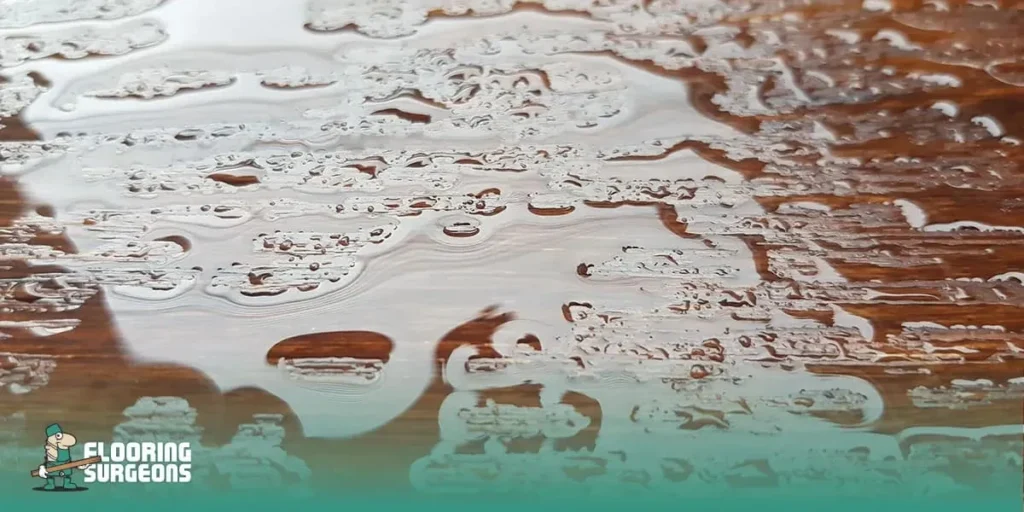
After-Care & Finishing Options Post Stain Removal
After removing water stains from wood floors, it’s essential to properly care for and finish the surface to restore its original beauty and protect it from future damage.
Reapply Finish for Protection
Once the stain is removed, especially from unfinished wood floors, it’s crucial to reapply a protective finish. For dark water stains on wood floors, sanding may be required before applying a high-quality wood finish to seal the surface and protect it from future stains. This will help ensure the floor remains resistant to moisture and preserve its overall durability. If you’re unsure how to remove dark water stains from wood floors or how do you remove water stains from wood floors, it’s recommended to consult a professional to ensure the job is done right and the floor is properly protected.
Polish for a Shiny Look
To restore a shine to laminate wood floors or hardwood floors, apply a polishing solution made specifically for wood surfaces. This step not only enhances the floor’s appearance but also adds a layer of protection against daily wear and tear. A gentle homemade laminate floor cleaner can also be used to maintain the shine and keep your floors looking pristine.
For more insights on achieving the perfect balance between beauty and budget, explore the cost of laminate flooring and discover how easy it is to keep your floors shining like new with the right care routine.
Routine Cleaning and Maintenance
For ongoing care, use a wood floor stain remover and follow a regular cleaning routine to prevent build-up. For engineered wood floors, avoid excessive water and use microfiber mops to clean without damaging the surface.
Conclusion
Acting quickly when a spill occurs can prevent lasting damage to wooden floors. Choosing the right wood, applying a protective finish, and stabilizing indoor humidity levels can also reduce the risk of stains and spills.
Hardwoods like oak and maple are naturally more resistant to stains than softwoods like pine and cedar. Glossy finishes also tend to offer better stain resistance compared to matte ones.
Regular maintenance, like vacuuming and occasional damp mopping, helps keep wooden floors looking their best and prevents stains. However, if you are unsure how to remove water stains from wood, it’s important to follow the correct methods to avoid damaging the floor.
If your floors require professional care, consulting an expert ensures they remain in top condition for years.




